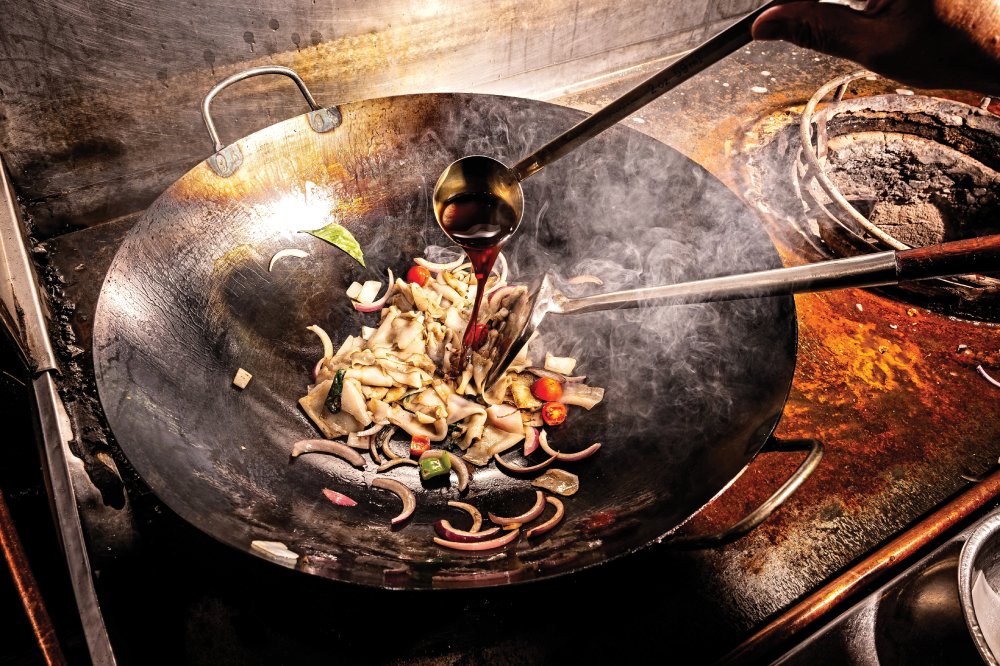Eat
 Thip Khao. Photo by Scott Suchman.
Thip Khao. Photo by Scott Suchman.
Three D.C. Chefs Work the Wok for Some of the Best Flavors in Town
August 31, 2023 @ 10:00am
The chefs explain why the wok is their go-to pan — even with cuisines it wasn’t originally intended for.
Meet three D.C. chefs: Seng Luangrath (Thip Khao), Paolo Dungca (Hiraya), and Simon Lam (Tiger Fork), who all swear by a well-seasoned wok. This versatile piece of kitchenware has been used in various forms for centuries across Asia, including in Laotian, Chinese and Filipino cuisines. This pan is best known for its high, sloping sides, helping to distribute heat evenly and quickly. It can also be a full body workout — precision-style cooking at high heats for a fiery effect and smoky flavors. We asked these chefs how they work their woks for everything from curries to fried rice and stir fries. Here’s what they had to say.
Seng Luangrath
Luangrath is a Laotian refugee who opened D.C.’s first Lao restaurant, Thip Khao in Columbia Heights, more than a decade ago. She is responsible for the #LaoFoodMovement promoting the Southeast Asian cuisine.
District Fray: What type of wok do you use?
Luangrath: I use a 22-inch hammer Cantonese wok. I season it first with high heat for 30 minutes, then wash with water and soap, and wipe it with cooking oil. I also use the wok to cook sticky rice. To do this, I use a 22-inch stainless steamer to steam the rice in a donut shape. It’s a unique way to cook.
Why do you like to cook with a wok? What’s one dish you use it for?
Lao cooking doesn’t require a wok, but I love to cook with it to create smoky flavors. I use it for a traditional Lao curry, similar to a Thai jungle curry. It’s made with lemongrass, galangal, shallot, garlic and makrut lime leaves, all cooked with oil in medium heat for a few minutes. Then, I add a protein over high heat with chicken stock. That helps create the smoky flavor. I season with fish sauce, toasted rice powder and dill. This is one of my favorite dishes and techniques to cook with added layers of smokiness and umami.
Do you have any advice for someone cooking with a wok at home?
I suggest heating up the wok before adding oil, then wait a few moments and swirl the oil over the wok before cooking. One of the most important things I do in my kitchen is teach my cooks to take their time, following the recipe, instructions and cooking methods. It’s very important to pay attention to small details.
3462 14th St. NW, DC; thipkhao.com // @thipkhaodc
View this post on Instagram
Paolo Dungca
Hiraya is scheduled to open this fall on H Street. The space is split in two, with an all-day cafe offering Filipino pastries and sandwiches on the first floor, and a sleek restaurant upstairs with a la carte small plates and a prix-fixe tasting menu from Chef Dungca.
District Fray: What’s your favorite dish to make with the wok?
Dungca: It’s a nice thing to use for any type of stir fry. The wok adds nuance to this type of dish, including smoky flavor and charred texture. But I also love to cook garlic rice in my wok. That’s probably the dish I am using my wok for — it just makes a better end product.
How do you care for your wok?
When you first get a wok, you need to season it well. I like to use aromatics to get it well-seasoned, things like onions, scallions and ginger. The majority of these aromatics will not only season the pan but add flavors to whatever dishes you are cooking with the wok. It’s almost like a cast iron skillet, where the pan gets better as you use it over time.
Where does the wok originate from?
The wok has been adapted through many cuisines and cultures. I think Filipino cuisine started using the wok through the Chinese. It isn’t the predominant tool found in our cooking; Filipino cooking tends to use pots and cauldrons for stews.
I came to the wok by working with Chef Peter Chang. He taught me how to really work the wok. It’s truly an art form and a pretty physical experience. There are so many dynamics at play, including the motion you put into wok cooking. He likes to say it’s all in the wrists.
1427 H St. NE, DC; hirayadc.com // @hirayadc
View this post on Instagram
Simon Lam
Lam recently joined Tiger Fork in Blagden Alley from Chang Chang. At Tiger Fork, he’s debuted a new menu featuring a small number of limited-time specials changing weekly, plus a late night menu after 9 p.m. in collaboration with DC Brau.
District Fray: What are advantages to cooking with a wok?
Lam: Once you master the wok, you can’t go back to anything else. The high heat from the wok’s flames gives a unique speed and flavor that can’t be produced with a normal stove-top and sauté pan. Besides just using the wok for stir fries, you can also deep fry, dry roast, braise, steam, boil and char. It’s very versatile.
What’s a must-try dish at Tiger Fork that uses the wok?
Our new addition to the weekly specials menu at Tiger Fork is a vegetarian wok-charred cumin and eggplant. It’s a dish inspired by Northwest China’s Uyghur people. We slice the eggplant into bite-sized pieces and use a dry wok to char them, giving a smoky barbecue flavor. Then, we add oil and add in roasted red bell pepper sauce, cooked down with sweated garlic, ginger and scallions — the holy trinity of Chinese cuisine. It’s just a quick toss with the roasted sauce to coat the charred eggplant. It’s plated with a garnish of labneh seasoned yogurt and cumin spices, fried crispy garlic and scallions. In total, this dish only takes three minutes to make.
What’s one thing people should know about wok cooking?
It’s fire control. Make sure you have the wok hot enough, but be very careful when adding in the oil. Always make sure the fire is off before adding oil to a hot pan, or else it will combust into a fireball.
922 N St. NW, DC; tigerforkdc.com // @tigerforkdc
View this post on Instagram
Want to know more about the best stalwart and latest food hotspots in the city? Join the District Fray community for exclusive access to restaurant guides and recommendations. Become a member and support local journalism today.







